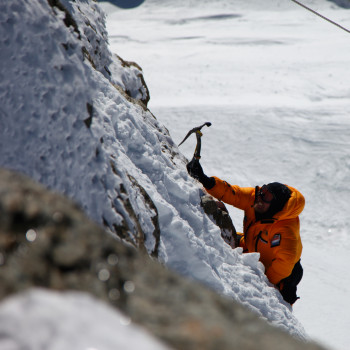For every four people who have reached the summit of K2, the world’s second-highest mountain, one has died in the attempt. In 2008, on one day 11 climbers died out of 24 who began the ascent. The details of that day are now the subject of a new documentary, “The Summit.” Filmmaker Nick Ryan sat down (close to sea level) with Brendan to discuss the “Savage Mountain” and the obsession that drives climbers to keep making attempts.

Brendan Francis Newnam: Nick, welcome. What prompted you to make this movie?
Nick Ryan: I was intrigued by the statistic that for every four people who stood on the summit of K2, one had died trying to get there. That was my initial draw into the story, and I thought why would any- why would anybody you know, put themselves up against such odds? There’d be like, you know, you’d have better odds playing Russian roulette.
Brendan Francis Newnam: Why is K2 so special? It’s not the tallest mountain.
Nick Ryan: It’s the second tallest mountain. It’s not much shorter than Everest; it’s only 250 meters shorter.
Brendan Francis Newnam: But it seems like it has a special appeal to climbers.
Nick Ryan: K2 has the reputation of being called “Killer Mountain,” “Savage Mountain,” because it’s much steeper. I think Wilco van Rooijen, the Dutch climber says it in the beginning. He says, “If you want a good story for a birthday party, you climb Everest. If you want to climb a real mountain, you climb K2.” I’m sure that’ll piss off a few climbers. The reality is, it is, it’s a much tougher climb, there’s objective danger on it, it’s a very steep mountain.
Brendan Francis Newnam: 25 people left that morning to summit K2; only 11 returned. Can you explain some of the reasons those people didn’t return?
Nick Ryan: Yeah, there was a lot of teams in K2, on K2 that year, and the weather was particularly bad, for something like six weeks they were all waiting to get to the summit, and all of a sudden this weather window opened up, and everybody was going to attempt to summit on this one day.
Brendan Francis Newnam: So there was kind of a traffic jam.
Nick Ryan: Exactly, yeah. And so basically they decided, we need to work together as one team, and what happens in this situation, as you know, the frailty is humanity in that people forget to do one thing, or something gets left behind. It starts as they started a little late, they started putting the ropes in too early, they ran out of rope because they started putting it in too early when they got to the section where they needed to actually have rope they had to wait while they went back and cut the rope they put down and brought in. So you know, before they’re even going anywhere, they find themselves four or five hours delayed. And then, you know, peoples’ oxygen is running low.
And the first guy to die literally was crossing back over a climber to get to the rest of his team on an 80-degree icy slope, he unclipped both of his safety lines, which is really not a done thing, hit his own cramp on, which is the spiky bits on your shoes if you will, and fell backwards down an 80-degree slope for 300 meters.
Brendan Francis Newnam: One of the interesting moments of this film is when that first person dies, you discuss the ethos on the mountain of whether or not you help someone. Like, what can be done at 8,000 feet for a person who died? Some people feel like they need to do something, others, you know, if I have to put myself at risk, that’s not worth it.
Nick Ryan: The unwritten code, it isn’t that you don’t help anybody. I think the best way of looking at it is that anyone who subscribes to climbing an 8,000 meter peak knows that when the chips are down, when things go wrong, you’re on your own.
Brendan Francis Newnam: And 8,000 meters above sea level is kind of where things change, cause that’s a really- not many people can withstand that high an altitude. In fact, this part of K2, and I think other mountains, any portion of the mountain above 8,000 feet is called the death zone. Can you explain what happens to people when they enter the “death zone?”
Nick Ryan: The death zone is kind of an area that’s anywhere above 7,500-7,700 meters. So, it’s an area where the air pressure is so much lower – it’s about one-third of what it is at sea level. And what that does to the body, the best way describing it is, you know, your organs slowly liquefy, your brain starts to fill with fluids. It’s basically an area where the humans just cannot live.
Brendan Francis Newnam: And you can combat some of those symptoms by using supplemental oxygen, but even with that oxygen, your body and brain aren’t functioning the way they normally would. So, after a couple of those climbers died on the way up, many climbers continued and summited that day, and no one else died until the descent, which I guess isn’t uncommon. When people are returning from a summit, that’s often the most dangerous part. Why is that?
Nick Ryan: When you reach the summit, you’re only halfway there. But you know, there is a sense of elation, a sense of joy, a sense of achievement. You know, your time on the summit is short-lived, and you start to descent. Now you’re probably tired, so you’re probably not keeping your eye on the ball.
Physically descending a mountain, like anything, going downhill it’s easier to fall going forward, moving downwards. You know, psychologically you’re probably thinking the hard part’s over, the struggle’s over, but it’s not.
Also, in this case, in 2008 a lot of the climbers had climbed with supplemental oxygen. By the time they reached the summit, that was gone. So, if you’ve climbed on supplemental oxygen to that point and it’s gone, you’re doubly in trouble, because your body has got this shock of having to deal with oxygen. And what happens is you become hypoxic. It’s like being drunk, you know, you become very apathetic, you want to sit down, not move, just lie there, you’re gonna be like, “Oh look, I’ll be fine,” and you know, “I’ll get down tomorrow,” or whatever. But you know, this is no place to be lying around.
Brendan Francis Newnam: Yeah. So nine climbers died on the descent from fatigue, from mini-avalanches, and your film suggests from trying to help one another, some of them. While I was watching this, I’m just thinking to myself, I had the same question you had at the beginning of this project, why does anyone do this? Do you have an answer?
Nick Ryan: Yeah, I mean I think at the beginning I was probably quite critical and like, “Why are they putting their lives at risk and other peoples’ lives at risk?” You know, it’s a first world problem, but I feel that like I get it now. I mean, I understand why, it’s obsession, it’s love. They love these environments, they love this thing, it’s a challenge. You know, I’m not critical of their reasons for wanting to do it.
Having seen K2 myself, I understand why anybody would want to go there. It is astonishingly beautiful.
Brendan Francis Newnam: Well your movie captures that beauty as well as the danger of that mountain. Nick Ryan, thanks for chatting with us.
Nick Ryan: It’s been a pleasure Brendan, thank you.


